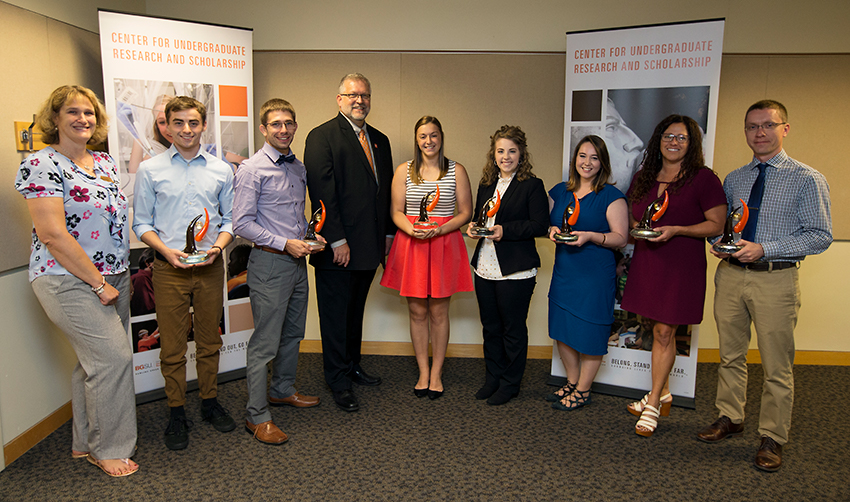Undergraduates honored for scholarly research

If Bowling Green State University undergraduate research is any indication, the future of scholarly discovery is in good shape. Students shared their original research at the annual Undergraduate Research Symposium on April 28. Working with their faculty mentors, they developed skills for inquiry, critical thinking, creativity and scholarship.
The University honored the winners of the 2018 symposium at an Aug. 14 ceremony with the presentation of special glass sculptures designed by BGSU art faculty member Joel O’Dorisio. Awards were given for oral and poster presentations. The symposium is hosted by the Center for Undergraduate Research and Scholarship (CURS), which provides support and resources for student researchers. Dr. John Fischer, interim provost and senior vice president for academic affairs, spoke at the ceremony and congratulated the winners.
“We had amazing presentations at this year’s symposium with an incredibly wide range of topics from all types of disciplines,” said CURS director Dr. Cordula Mora. “It has been a pleasure to see the scope of the symposium grow each year, and I would encourage faculty to start thinking already now, with the fall semester almost upon us, to plan to have their students present their research, scholarly and creative works at next year’s event.”
Also honored at the Aug. 14 event was the Undergraduate Faculty Mentor of the Year, Dr. Virginia Dubasik, assistant professor in communication sciences and disorders.
One of her student nominators for the award wrote: “Dr. Dubasik strives to provide ample opportunities for undergraduate students in research. She allows students to build up their confidence when working with her by allowing autonomy in research but still providing the necessary help to be successful. She has made a very large impact on my experience at BGSU, and has inspired me to become involved in more research. She has allowed me to build confidence in my ability to conduct research through my honors project and through a project being presented at the Ohio Academy of Science annual conference, and helped me to build a proposal to hopefully present at a national conference in the fall.”
The student winners in oral presentation were Noah Dunn, Rebecca Ebert and Brad Holmes.
Dunn, an engineering technologies student, researched factors that could foil an autonomous vehicle’s ability to recognize objects such as stop signs. Vandalism might be one way this could occur. Working with instructor Mikhail Shilov, Dunn said, “Our research attempts to find an assistant algorithm for stop sign identification. This algorithm could be implemented in various autonomous vehicles, supplementing their current object recognition systems.”
Ebert’s study looked at a specific grammatical structure, the verb –s sound (e.g., walks, goes), analyzing whether its placement in a sentence and in a word, before or after a vowel or a consonant, affects its pronunciation. Her goal is to shed light on better therapy tools for children. Her faculty mentor was Dr. Colleen Fitzgerald, assistant professor of communication sciences and disorders.
In his study, “Community Environmental Protection: Resistance Against Corporate Projects across the Country,” philosophy student Holmes researched groups in towns, cities and counties in four states who had organized against corporate projects they viewed as environmentally, economically or socially hazardous, with varying degrees of success. A student of Dr. Kevin Vallier, an associate professor of philosophy, Holmes shared his results and his theories as to why these corporate projects take place and what it might take to stop them.
Winning for their poster presentations were Matthew Franks, Francesca Leo and the team of Alyssa Hulthen and Mia Eberts.
Franks studied a topic highly pertinent to agriculture in northwest Ohio and internationally: “The Effect of Agricultural Best Management Practices on Soil Quality.” Utilizing the Blanchard River Demonstration Farm Network, he compared the effects of tilling versus no tilling, cover crops to no cover crops, and use of various nutrient management strategies to determine their effect on soil quality. An additional benefit of improved soil quality is the reduction of nutrient runoff into water bodies such as Lake Erie, which helps prevent harmful algal blooms. His faculty mentor was Dr. Angelica Vazquez Ortega, assistant professor in the School of Earth, Environment and Society.
Leo’s project, “Playing Without Pain,” was designed to provide collegiate music students with resources to treat and prevent performance-based injuries and pain through an interactive website. She surveyed BGSU student musicians to determine the extent of the problem, a common bane of musicians. Working with mentor Dr. Lisa Martin, assistant professor of music education, Leo’s goal is to provide students with the help they need to pursue a healthy and prosperous career in music.
Communication Sciences and Disorders undergraduates Hulthen and Eberts, students of Dubasik, presented the results of their work “Examining Variability in Productive Syntax within a Set of Triplets.” Their study explored lexical diversity of typically developing triplets and singleton siblings. Language samples between the ages of 18 and 36 months were analyzed using Systematic Analysis of Language Transcripts to obtain the total number of words, number of different words, and type-token ratio (the total number of different words divided by the total number of words). They reported lexical diversity similarities and differences.
Updated: 09/11/2018 09:10AM
